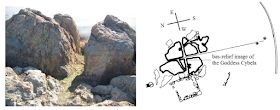Good few years ago I spoke to a speleologist who explored a lot of caves with ancient temples and burial places. And he said that he found it interesting "that all the caves with traces of some kind of religious activity, which he explored, were facing the sun"...
This is Utroba (Womb) Cave (new name given to the cave for obvious reasons) which was (re)discovered in the Eastern Rhodope mountains, Bulgaria in 2001...The cave pic by Ivo Filipov
This natural cave, which was once 16 meters deep, was made deeper by excavation (around 3000 years ago) and is now 22 meters deep. At the bottom of the cave is a man made altar which means that the cave was used as a temple...
At midday, light enters the cave through an opening in the ceiling, projecting an image of a phallus on to the floor.
Once a year, on Winter Solstice, the phallus shadow grows long enough to reach the alter. Symbolic penetration of the mother earth by the father sun? Well yes 🙂
The cave is located in the area full of Thracian rock cut temples.
This rock sanctuary (solar observatory), called "Harman Kaya“, is in the same area....It has three viewfinders - 1-summer solstice, 2- winter solstice, and 3- equinox...
This rock cut observatory, called "Cabile", is also in the same are. Here the sunrise during the summer solstice can be observed. The bas-relief image of the Goddess Cybela is located at the west side of the sanctuary. Next to it are stone foundations of a large square building (temple?)...
More info about these ancient observatories and temples can be found in "EVOLUTION OF ASTRONOMICAL FACILITIES AND PRACTICES IN ANCIENT THRACE" by Alexey Stoev, Penka Maglova and Mina Spasova




wow
ReplyDeleteBeautiful
ReplyDelete